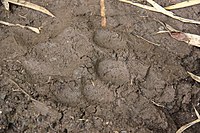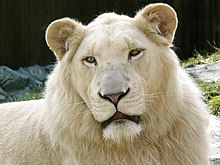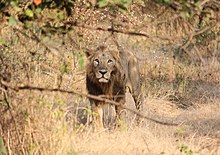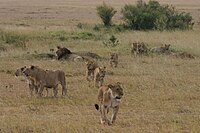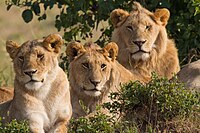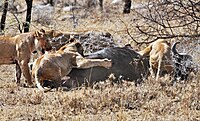The lion (Panthera leo) is a species in the family Felidae; it is a muscular, deep-chested cat with a short, rounded head, a reduced neck and round ears, and a hairy tuft at the end of its tail. It is sexually dimorphic; male lions have a prominent mane, which is the most recognisable feature of the species. With a typical head-to-body length of 184–208 cm (72–82 in) they are larger than females at 160–184 cm (63–72 in). It is a social species, forming groups called prides. A lion pride consists of a few adult males, related females and cubs. Groups of female lions usually hunt together, preying mostly on large ungulates. The lion is an apex and keystone predator, although some lions scavenge when opportunities occur, and have been known to hunt humans, although the species typically does not.
Typically, the lion inhabits grasslands and savannas but is absent in dense forests. It is usually more diurnal than other big cats, but when persecuted it adapts to being active at night and at twilight. In the Pleistocene, the lion ranged throughout Eurasia, Africa and North America but today it has been reduced to fragmented populations in Sub-Saharan Africa and one critically endangered population in western India. It has been listed as Vulnerable on the IUCN Red List since 1996 because populations in African countries have declined by about 43% since the early 1990s. Lion populations are untenable outside designated protected areas. Although the cause of the decline is not fully understood, habitat loss and conflicts with humans are the greatest causes for concern.
One of the most widely recognised animal symbols in human culture, the lion has been extensively depicted in sculptures and paintings, on national flags, and in contemporary films and literature. Lions have been kept in menageries since the time of the Roman Empire and have been a key species sought for exhibition in zoological gardens across the world since the late 18th century. Cultural depictions of lions were prominent in the Upper Paleolithic period; carvings and paintings from the Lascaux and Chauvet Caves in France have been dated to 17,000 years ago, and depictions have occurred in virtually all ancient and medieval cultures that coincided with the lion's former and current ranges.
Contents
- 1Etymology
- 2Taxonomy
- 2.1Subspecies
- 2.2Fossil records
- 2.3Evolution
- 2.4Dubious subspecies
- 2.5Hybrids
- 3Description
- 3.1Mane
- 3.2Colour variation
- 4Distribution and habitat
- 4.1Historical range
- 5Behaviour and ecology
- 5.1Group organisation
- 5.2Hunting and diet
- 5.2.1Predator competition
- 5.3Reproduction and life cycle
- 5.4Health
- 5.5Communication
- 6Conservation
- 6.1In Africa
- 6.2In Asia
- 6.3Captive breeding
- 7Interactions with humans
- 7.1In zoos and circuses
- 7.2Hunting and games
- 7.3Man-eating
- 8Cultural significance
- 8.1Sub-Saharan Africa
- 8.2Near East
- 8.3Far East
- 8.4Western world
- 9See also
- 10References
- 10.1Cited texts
- 11External links
Etymology
The word 'lion' is derived from Latin: leo[4] and Ancient Greek: λέων (leon).[5] The word lavi (Hebrew: לָבִיא) may also be related.[6] The generic name Panthera is traceable to the classical Latin word 'panthēra' and the ancient Greek word πάνθηρ 'panther'.[7] Panthera is phonetically similar to the Sanskrit word पाण्डर pând-ara meaning 'pale yellow, whitish, white'.[8]
Taxonomy
Felis leo was the scientific name used by Carl Linnaeus in 1758, who described the lion in his work Systema Naturae.[3] The genus name Panthera was coined by German naturalist Lorenz Oken in 1816.[13] Between the mid-18th and mid-20th centuries, 26 lion specimens were described and proposed as subspecies, of which 11 were recognised as valid in 2005.[1] They were distinguished on the basis of appearance, size and colour of mane. Because these characteristics show much variation between individuals, most of these forms were probably not true subspecies, especially because they were often based upon museum material with "striking, but abnormal" morphological characteristics.[14]
Subspecies
In the 19th and 20th centuries, several lion type specimens were described and proposed as subspecies, with about a dozen recognised as valid taxa until 2017.[1] Between 2008 and 2016, IUCN Red List assessors used only two subspecific names: P. l. leo for African lion populations and P. l. persica for the Asiatic lion population.[2][15][16] In 2017, the Cat Classification Task Force of the Cat Specialist Group revised lion taxonomy, and recognises two subspecies based on results of several phylogeographic studies on lion evolution, namely:[17]
- P. l. leo (Linnaeus, 1758) − the nominate lion subspecies includes the Asiatic lion, the regionally extinct Barbary lion, and lion populations in West and northern parts of Central Africa.[17] Synonyms include P. l. persica (Meyer, 1826), P. l. senegalensis (Meyer, 1826), P. l. kamptzi (Matschie, 1900), and P. l. azandica (Allen, 1924).[1] Some authors referred to it as 'northern lion' and 'northern subspecies'.[18][19]
- P. l. melanochaita (Smith, 1842) − includes the extinct Cape lion and lion populations in East and Southern African regions.[17] Synonyms include P. l. somaliensis (Noack 1891), P. l. massaica (Neumann, 1900), P. l. sabakiensis (Lönnberg, 1910), P. l. bleyenberghi (Lönnberg, 1914), P. l. roosevelti (Heller, 1914), P. l. nyanzae (Heller, 1914), P. l. hollisteri (Allen, 1924), P. l. krugeri (Roberts, 1929), P. l. vernayi (Roberts, 1948), and P. l. webbiensis (Zukowsky, 1964).[1][20] It has been referred to as 'southern subspecies' and 'southern lion'.[19]
Lion samples from some parts of the Ethiopian Highlands cluster genetically with those from Cameroon and Chad, while lions from other areas of Ethiopia cluster with samples from East Africa. Researchers therefore assume that Ethiopia is a contact zone between the two subspecies.[21]
Fossil records
Other lion subspecies or sister species to the modern lion existed in prehistoric times:[23]
- P. l. sinhaleyus was a fossil carnassial excavated in Sri Lanka, which was attributed to a lion. It is thought to have become extinct around 39,000 years ago.[24]
- P. leo fossilis, P. fossilis or P. spelaea fossilis was larger than the modern lion and lived in the Middle Pleistocene. Bone fragments were excavated in caves in the United Kingdom, Germany, Italy and Czech Republic.[25][26]
- Panthera spelaea lived in Eurasia and Beringia during the Late Pleistocene. It became extinct due to climate warming latest by 11,900 years ago.[27] Bone fragments excavated in European, North Asian, Canadian and Alaskan caves indicate that it ranged from Europe across Siberia into western Alaska.[28] It likely derived from P. fossilis,[29] and was genetically isolated and highly distinct from the lion in Africa and Asia.[30][29] It is depicted in Paleolithic cave paintings, ivory carvings, and clay busts.[31]
- P. l. atrox or P. atrox ranged in the Americas from Canada to possibly Patagonia.[32][32] The American lion arose when a cave lion population in Beringia became isolated south of the Cordilleran Ice Sheet about 370,000 years ago.[33][34] A fossil from Edmonton dates to 11,355 ± 55 years ago.[35]
Evolution
The lion's closest relatives are the other species of the genus Panthera, namely tiger, snow leopard, jaguar, and leopard. Results of phylogenetic studies published in 2006 and 2009 indicate that the jaguar and the lion belong to one sister group that diverged about 2.06 million years ago.[9][10] Results of later studies indicate that the leopard and the lion belong to the same sister group, which diverged 3.1–1.95 million years ago.[11][12] The geographic origin of the Panthera is most likely northern Central Asia. The leopard-lion clade was distributed in the Asian and African Palearctic since at least the Early Pliocene. The clade consisting of lion and Eurasian cave lion is thought to have diverged in Africa or Holarctic Asia,[36] 2.93–1.23 million years ago.[29] Hybridisation between ancestors of lion and snow leopard lineages may have continued until about 2.1 million years ago.[37] The Eurasian and American cave lions became extinct at the end of the last glacial period without mitochondrial descendants on other continents.[30][38][39]
The modern lion was probably widely distributed in Africa during the Middle Pleistocene and started to diverge in sub-Saharan Africa during the Late Pleistocene. Lion populations in East and Southern Africa became separated from populations in West and North Africa when the equatorial rainforest expanded 183,500–81,800 years ago. The expansion of the Sahara 83,100–26,600 years ago caused the separation of populations in West and North Africa. As the rainforest decreased, thus giving rise to more open habitats, lions moved from West to Central Africa. Lions from North Africa dispersed to southern Europe and Asia 38,800–8,300 ago.[40] Extinction of lions in southern Europe, North Africa and the Middle East interrupted gene flow between lion populations in Asia and Africa. Genetic evidence revealed numerous mutations in lion samples from East and Southern Africa, which indicates that this group has a longer evolutionary history than genetically less diverse lion samples from Asia and West and Central Africa.[41] Results of phylogeographic research indicate that the two living lion subspecies diverged about 245,000 years ago.[21]
Dubious subspecies
- P. l. europaea was proposed for subfossil remains of lions excavated in Southern Europe and date to between the Late Neolithic and the Early Iron Age.[42]
- P. l. mesopotamica was described on the basis of a relief from the Neo-Assyrian Period made between 1000 BC and 600 BC in ancient Mesopotamia.[43]
Hybrids
In zoos, lions have been bred with tigers to create hybrids for the curiosity of visitors or for scientific purpose.[44][45] The liger is bigger than a lion and a tiger, whereas most tigons are relatively small compared to their parents because of reciprocal gene effects.[46][47] The leopon is a hybrid between a lion and leopard.[48]
Description
The lion is a muscular, deep-chested cat with a short, rounded head, a reduced neck and round ears. Its fur varies in colour from light buff to silvery grey, yellowish red and dark brown. The colours of the underparts are generally lighter. A new-born lion has dark spots, which fade as the cub reaches adulthood, although faint spots often may still be seen on the legs and underparts. The lion is the only member of the cat family that displays obvious sexual dimorphism. Males have broader heads and a prominent mane that grows downwards and backwards covering most of the head, neck, shoulders, and chest. The mane is typically brownish and tinged with yellow, rust and black hairs.[49][50]
The tail of all lions ends in a dark, hairy tuft that in some lions conceals an approximately 5 mm (0.20 in)-long, hard "spine" or "spur" that is formed from the final, fused sections of tail bone. The functions of the spur are unknown. The tuft is absent at birth and develops at around 51⁄2 months of age. It is readily identifiable by the age of seven months.[51]
Of the living felid species, the lion is rivaled only by the tiger in length, weight and height at the shoulder.[52] Its skull is very similar to that of the tiger, although the frontal region is usually more depressed and flattened, and has a slightly shorter postorbital region and broader nasal openings than those of the tiger. Due to the amount of skull variation in the two species, usually only the structure of the lower jaw can be used as a reliable indicator of species.[53][54]
The size and weight of adult lions varies across global range and habitats.[55][56][57][58] Accounts of a few individuals that were larger than average exist from Africa and India.[49][59][60][61]
| Average | Female lions | Male lions |
|---|---|---|
| Head-and-body length | 160–184 cm (63–72 in)[62] | 184–208 cm (72–82 in)[62] |
| Tail length | 72–89.5 cm (28.3–35.2 in)[62] | 82.5–93.5 cm (32.5–36.8 in)[62] |
| Weight | 118.37–143.52 kg (261.0–316.4 lb) in Southern Africa,[55] 119.5 kg (263 lb) in East Africa,[55] 110–120 kg (240–260 lb) in India[56] | 186.55–225 kg (411.3–496.0 lb) in Southern Africa,[55] 174.9 kg (386 lb) in East Africa,[55] 160–190 kg (350–420 lb) in India[56] |
Mane
The lion's mane is the most recognisable feature of the species.[20] It starts growing when lions are about a year old. Mane colour varies and darkens with age; research shows its colour and size are influenced by environmental factors such as average ambient temperature. Mane length apparently signals fighting success in male–male relationships; darker-maned individuals may have longer reproductive lives and higher offspring survival, although they suffer in the hottest months of the year. The presence, absence, colour and size of the mane are associated with genetic precondition, sexual maturity, climate and testosterone production; the rule of thumb is that a darker, fuller mane indicates a healthier animal. In Serengeti National Park, female lions favour males with dense, dark manes as mates.[63][64] The main purpose of the mane is thought be the protection of the neck and throat in territorial fights with rivals.[65] Cool ambient temperature in European and North American zoos may result in a heavier mane.[66] Asiatic lions usually have sparser manes than average African lions.[67]
Almost all male West African lions in Pendjari National Park are either maneless or have very short manes.[68] Maneless lions have also been reported in Senegal, in Sudan's Dinder National Park and in Tsavo East National Park, Kenya.[69] The original male white lion from Timbavati in South Africa was also maneless. The hormone testosterone has been linked to mane growth; castrated lions often have little to no mane because the removal of the gonads inhibits testosterone production.[70] Increased testosterone may be the cause of maned lionesses reported in northern Botswana.[71]
The lion's mane may have evolved around 320,000–190,000 years ago.[72] Cave paintings of extinct Eurasian cave lions almost exclusively show hunting animals without a mane; some suggest that this is evidence that they were indeed maneless.[73]
Colour variation
The white lion is a rare morph with a genetic condition called leucism that is caused by a double recessive allele. It is not albino; it has normal pigmentation in the eyes and skin. White lions have occasionally been encountered in and around Kruger National Park and the adjacent Timbavati Private Game Reserve in eastern South Africa. They were removed from the wild in the 1970s, thus decreasing the white lion gene pool. Nevertheless, 17 births have been recorded in five prides between 2007 and 2015.[74] White lions are selected for breeding in captivity.[75] They have reportedly been bred in camps in South Africa for use as trophies to be killed during canned hunts.[76]
Distribution and habitat
African lions live in scattered populations across Sub-Saharan Africa. The lion prefers grassy plains and savannahs, scrub bordering rivers and open woodlands with bushes. It is absent from rainforest and rarely enters closed forest. On Mount Elgon, the lion has been recorded up to an elevation of 3,600 m (11,800 ft) and close to the snow line on Mount Kenya.[49] Lions occur in savannah grasslands with scattered acacia trees, which serve as shade.[77] The Asiatic lion now only survives in and around Gir National Park in Gujarat, western India. Its habitat is a mixture of dry savannah forest and very dry, deciduous scrub forest.[15]
Historical range
In Africa, the range of the lion originally spanned most of the central rainforest zone and the Sahara desert.[78] In the 1960s, it became extinct in North Africa, except in the southern part of Sudan.[79][80][81]
In southern Europe and Asia, the lion once ranged in regions where climatic conditions supported an abundance of prey.[82] In Greece, it was common as reported by Herodotus in 480 BC; by 300 BC, it was considered rare and extirpated by 100 AD.[49] Until the 10th century, it ranged in the Caucasus, its last European outpost.[54] It lived in Palestine until the Middle Ages, and in Southwest Asia until the late 19th century. By the late 19th century, it had been extirpated in most of Turkey.[83] The last live lion in Iran was sighted in 1942, about 65 km (40 mi) northwest of Dezful.[84] The corpse of a lioness was found on the banks of the Karun river in Khūzestān Province in 1944. No subsequent reliable records exist from Iran.[85] The lion population in Pakistan India once ranged from Sind and Punjab to Bengal and the Narmada River in Central India.[86]
Behaviour and ecology
Lions spend much of their time resting; they are inactive for about 20 hours per day.[87] Although lions can be active at any time, their activity generally peaks after dusk with a period of socialising, grooming and defecating. Intermittent bursts of activity continue until dawn, when hunting most often takes place. They spend an average of two hours a day walking and 50 minutes eating.[88]
Group organisation
The lion is the most social of all wild felid species, living in groups of related individuals with their offspring. Such a group is called a "pride". Groups of male lions are called "coalitions".[89] Females form the stable social unit in a pride and do not tolerate outside females.[90] Membership only changes with the births and deaths of lionesses,[91] although some females leave and become nomadic.[92] The average pride consists of around 15 lions, including several adult females and up to four males and their cubs of both sexes. Large prides, consisting of up to 30 individuals, have been observed.[93] The sole exception to this pattern is the Tsavo lion pride that always has just one adult male.[94] Male cubs are excluded from their maternal pride when they reach maturity at around two or three years of age.[92]
Some lions are "nomads" that range widely and move around sporadically, either in pairs or alone.[89] Pairs are more frequent among related males who have been excluded from their birth pride. A lion may switch lifestyles; nomads can become residents and vice versa.[95] Interactions between prides and nomads tend to be hostile, although pride females in estrus allow nomadic males to approach them.[96] Males spend years in a nomadic phase before gaining residence in a pride.[97] A study undertaken in the Serengeti National Park revealed that nomadic coalitions gain residency at between 3.5 and 7.3 years of age.[98] In Kruger National Park, dispersing male lions move more than 25 km (16 mi) away from their natal pride in search of their own territory. Females lions stay closer to their natal pride. Therefore, female lions in an area are more closely related to each other than male lions in the same area.[99]
The area occupied by a pride is called a "pride area" whereas that occupied by a nomad is a "range".[89] Males associated with a pride tend to stay on the fringes, patrolling their territory. The reasons for the development of sociality in lionesses – the most pronounced in any cat species – are the subject of much debate. Increased hunting success appears to be an obvious reason, but this is uncertain upon examination; coordinated hunting allows for more successful predation but also ensures non-hunting members reduce per capita calorific intake. Some females, however, take a role raising cubs that may be left alone for extended periods. Members of the pride tend to regularly play the same role in hunts and hone their skills. The health of the hunters is the primary need for the survival of the pride; hunters are the first to consume the prey at the site it is taken. Other benefits include possible kin selection; sharing food within the family; protecting the young, maintaining territory and individual insurance against injury and hunger.[59]
Both males and females defend the pride against intruders, but the male lion is better-suited for this purpose due to its stockier, more powerful build. Some individuals consistently lead the defence against intruders, while others lag behind.[100] Lions tend to assume specific roles in the pride; slower-moving individuals may provide other valuable services to the group.[101] Alternatively, there may be rewards associated with being a leader that fends off intruders; the rank of lionesses in the pride is reflected in these responses.[102] The male or males associated with the pride must defend their relationship with the pride from outside males who may attempt to usurp them.
Asiatic lion prides differ in group composition. Male Asiatic lions are solitary or associate with up to three males, forming a loose pride while females associate with up to 12 other females, forming a stronger pride together with their cubs. Female and male lions associate only when mating.[103] Coalitions of males hold territory for a longer time than single lions. Males in coalitions of three or four individuals exhibit a pronounced hierarchy, in which one male dominates the others and mates more frequently.[104]
Hunting and diet
The lion is a generalist hypercarnivore[105] and is considered to be both an apex and keystone predator due to its wide prey spectrum.[106] Its prey consists mainly of mammals – particularly ungulates – weighing 190–550 kg (420–1,210 lb) with a preference for blue wildebeest, plains zebra, African buffalo, gemsbok and giraffe. Lions also hunt common warthog depending on availability, although the species is below the preferred weight range.[107] In India, sambar deer and chital are the most commonly recorded wild prey,[50][107][108] while domestic livestock may contribute significantly to their diet.[108] They usually avoid fully grown adult elephants, rhinoceroses and hippopotamus, as well as small prey like dik-dik, hyrax, hare and vervet monkey.[109] Unusual prey items include porcupines and small reptiles. Lions kill other predators such as leopard, cheetah and spotted hyena but seldom consume them.[110]
Young lions first display stalking behaviour at around three months of age, although they do not participate in hunting until they are almost a year old and begin to hunt effectively when nearing the age of two.[111] Single lions are capable of bringing down zebra and wildebeest, while larger prey like buffalo and giraffes are riskier.[95] In Chobe National Park, large prides have been observed hunting subadult and even adult African bush elephants.[112][113] In typical hunts, each lioness has a favoured position in the group, either stalking prey on the "wing", then attacking, or moving a smaller distance in the centre of the group and capturing prey fleeing from other lionesses. Males attached to prides do not usually participate in group hunting.[114] Some evidence suggests, however, that males are just as successful as females; they are typically solo hunters who ambush prey in small bushland.[115]
Lions are not particularly known for their stamina; for instance, a lioness' heart comprises only 0.57% of her body weight and a male's is about 0.45% of his body weight, whereas a hyena's heart comprises almost 1% of its body weight.[116] Thus, lions only run quickly in short bursts[117] and need to be close to their prey before starting the attack. They take advantage of factors that reduce visibility; many kills take place near some form of cover or at night.[118] The lion's attack is short and powerful; they attempt to catch prey with a fast rush and final leap. They usually pull it down by the rump and kill by a strangling bite to the throat. They also kill prey by enclosing its mouth and nostrils in their jaws.[119]
Lions typically consume prey at the location of the hunt but sometimes drag large prey into cover.[120] They tend to squabble over kills, particularly the males. Cubs suffer most when food is scarce but otherwise all pride members eat their fill, including old and crippled lions, which can live on leftovers.[95] Large kills are shared more widely among pride members.[121] An adult lioness requires an average of about 5 kg (11 lb) of meat per day while males require about 7 kg (15 lb).[122] Lions gorge themselves and eat up to 30 kg (66 lb) in one session;[85] if it is unable to consume all of the kill, it rests for a few hours before continuing to eat. On hot days, the pride retreats to shade with one or two males standing guard.[120] Lions defend their kills from scavengers such as vultures and hyenas.[95]
Lions scavenge on carrion when the opportunity arises; they scavenge animals dead from natural causes such as disease or those that were killed by other predators. Scavenging lions keep a constant lookout for circling vultures, which indicate the death or distress of an animal.[123] Most carrion on which both hyenas and lions feed upon are killed by hyenas rather than lions.[58] Carrion is thought to provide a large part of lion diet.[124]







